Civil Engineering Report: Infrastructure Project Planning and Analysis
VerifiedAdded on 2021/03/16
|14
|3155
|268
Report
AI Summary
This report provides a detailed analysis of various aspects of civil engineering, focusing on construction projects. It begins with an introduction to civil engineering and its core principles, followed by an in-depth exploration of earthworks activities, including excavation, demolition, and material transport. The report then delves into complex foundation techniques, piling works, and drainage systems. It also covers culvert design, underpass construction, and large-scale earthmoving approaches. Safety is a key focus, with discussions on hazards, risks, and safety arrangements for excavations, confined spaces, and highway works. The report also examines structural engineering-related health and safety laws, environmental, quality, geotechnical, and economic contexts of civil engineering processes, and methods for dealing with field and slope stabilization problems. The report also describes the processes and procedures utilized in the construction of highways, including both gravel and concrete-based roads, and concludes with a conceptual plan for a modern infrastructure project.
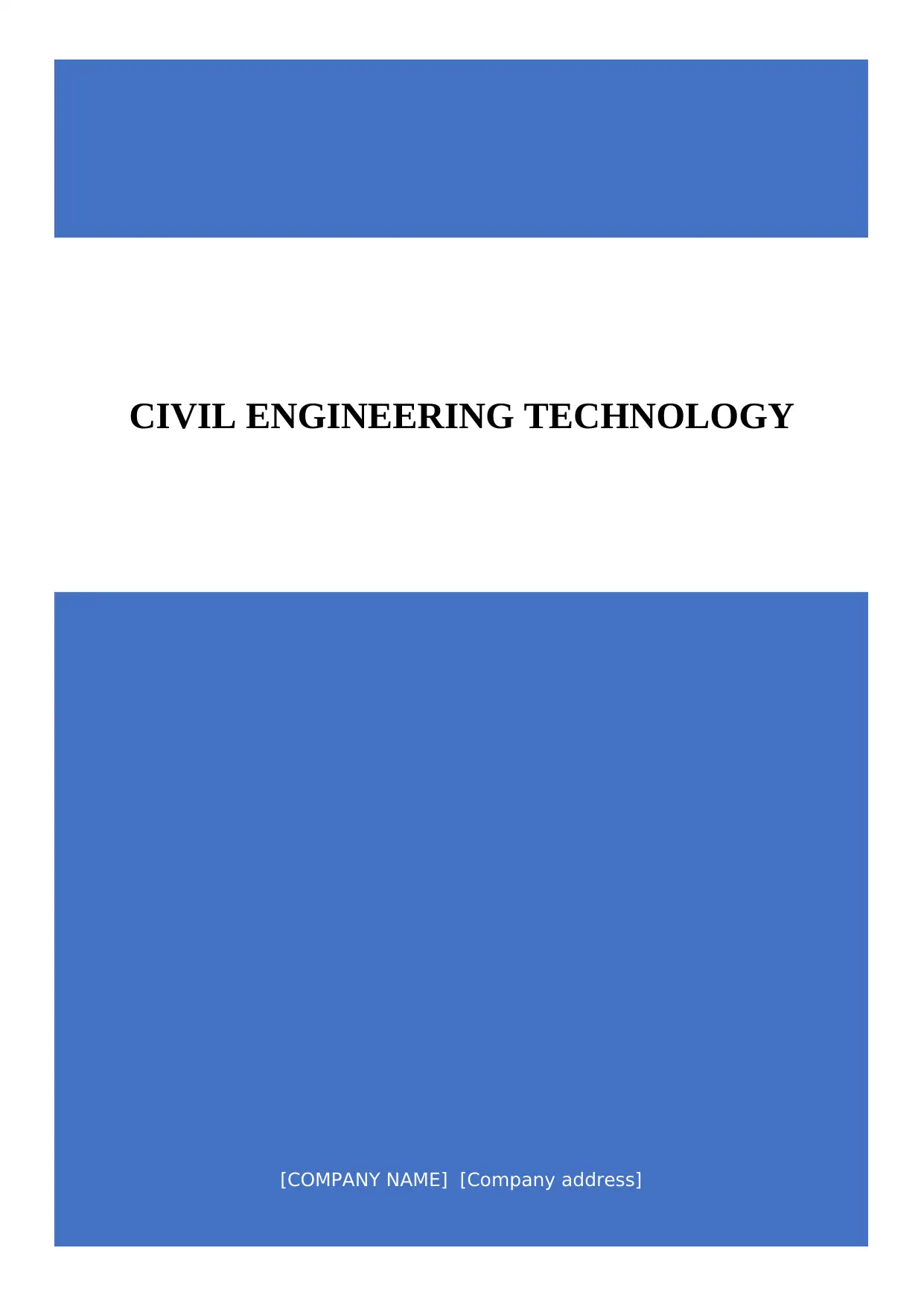
[COMPANY NAME] [Company address]
CIVIL ENGINEERING TECHNOLOGY
CIVIL ENGINEERING TECHNOLOGY
Paraphrase This Document
Need a fresh take? Get an instant paraphrase of this document with our AI Paraphraser
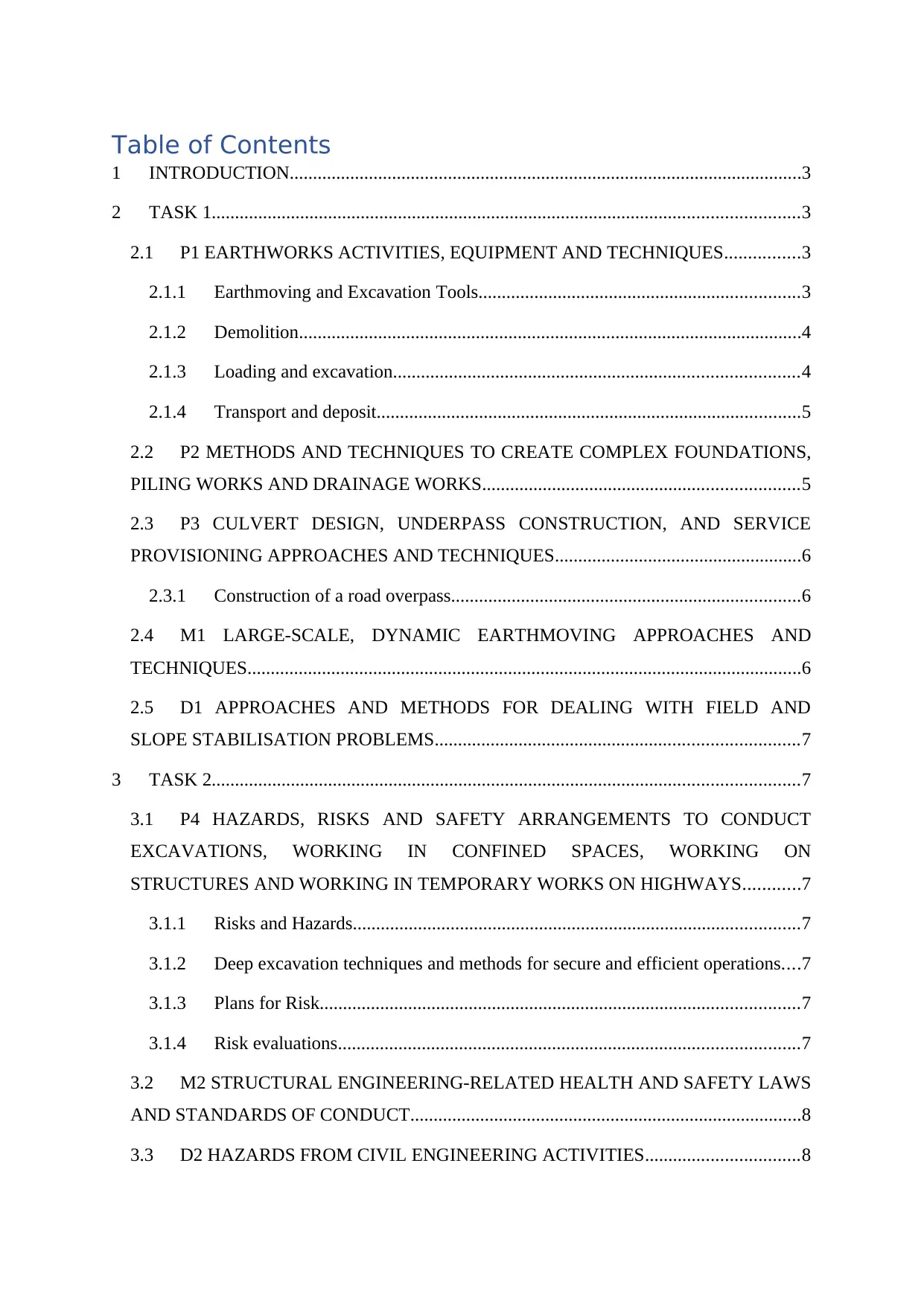
Table of Contents
1 INTRODUCTION..............................................................................................................3
2 TASK 1..............................................................................................................................3
2.1 P1 EARTHWORKS ACTIVITIES, EQUIPMENT AND TECHNIQUES................3
2.1.1 Earthmoving and Excavation Tools.....................................................................3
2.1.2 Demolition............................................................................................................4
2.1.3 Loading and excavation.......................................................................................4
2.1.4 Transport and deposit...........................................................................................5
2.2 P2 METHODS AND TECHNIQUES TO CREATE COMPLEX FOUNDATIONS,
PILING WORKS AND DRAINAGE WORKS....................................................................5
2.3 P3 CULVERT DESIGN, UNDERPASS CONSTRUCTION, AND SERVICE
PROVISIONING APPROACHES AND TECHNIQUES.....................................................6
2.3.1 Construction of a road overpass...........................................................................6
2.4 M1 LARGE-SCALE, DYNAMIC EARTHMOVING APPROACHES AND
TECHNIQUES.......................................................................................................................6
2.5 D1 APPROACHES AND METHODS FOR DEALING WITH FIELD AND
SLOPE STABILISATION PROBLEMS..............................................................................7
3 TASK 2..............................................................................................................................7
3.1 P4 HAZARDS, RISKS AND SAFETY ARRANGEMENTS TO CONDUCT
EXCAVATIONS, WORKING IN CONFINED SPACES, WORKING ON
STRUCTURES AND WORKING IN TEMPORARY WORKS ON HIGHWAYS............7
3.1.1 Risks and Hazards................................................................................................7
3.1.2 Deep excavation techniques and methods for secure and efficient operations....7
3.1.3 Plans for Risk.......................................................................................................7
3.1.4 Risk evaluations...................................................................................................7
3.2 M2 STRUCTURAL ENGINEERING-RELATED HEALTH AND SAFETY LAWS
AND STANDARDS OF CONDUCT....................................................................................8
3.3 D2 HAZARDS FROM CIVIL ENGINEERING ACTIVITIES.................................8
1 INTRODUCTION..............................................................................................................3
2 TASK 1..............................................................................................................................3
2.1 P1 EARTHWORKS ACTIVITIES, EQUIPMENT AND TECHNIQUES................3
2.1.1 Earthmoving and Excavation Tools.....................................................................3
2.1.2 Demolition............................................................................................................4
2.1.3 Loading and excavation.......................................................................................4
2.1.4 Transport and deposit...........................................................................................5
2.2 P2 METHODS AND TECHNIQUES TO CREATE COMPLEX FOUNDATIONS,
PILING WORKS AND DRAINAGE WORKS....................................................................5
2.3 P3 CULVERT DESIGN, UNDERPASS CONSTRUCTION, AND SERVICE
PROVISIONING APPROACHES AND TECHNIQUES.....................................................6
2.3.1 Construction of a road overpass...........................................................................6
2.4 M1 LARGE-SCALE, DYNAMIC EARTHMOVING APPROACHES AND
TECHNIQUES.......................................................................................................................6
2.5 D1 APPROACHES AND METHODS FOR DEALING WITH FIELD AND
SLOPE STABILISATION PROBLEMS..............................................................................7
3 TASK 2..............................................................................................................................7
3.1 P4 HAZARDS, RISKS AND SAFETY ARRANGEMENTS TO CONDUCT
EXCAVATIONS, WORKING IN CONFINED SPACES, WORKING ON
STRUCTURES AND WORKING IN TEMPORARY WORKS ON HIGHWAYS............7
3.1.1 Risks and Hazards................................................................................................7
3.1.2 Deep excavation techniques and methods for secure and efficient operations....7
3.1.3 Plans for Risk.......................................................................................................7
3.1.4 Risk evaluations...................................................................................................7
3.2 M2 STRUCTURAL ENGINEERING-RELATED HEALTH AND SAFETY LAWS
AND STANDARDS OF CONDUCT....................................................................................8
3.3 D2 HAZARDS FROM CIVIL ENGINEERING ACTIVITIES.................................8
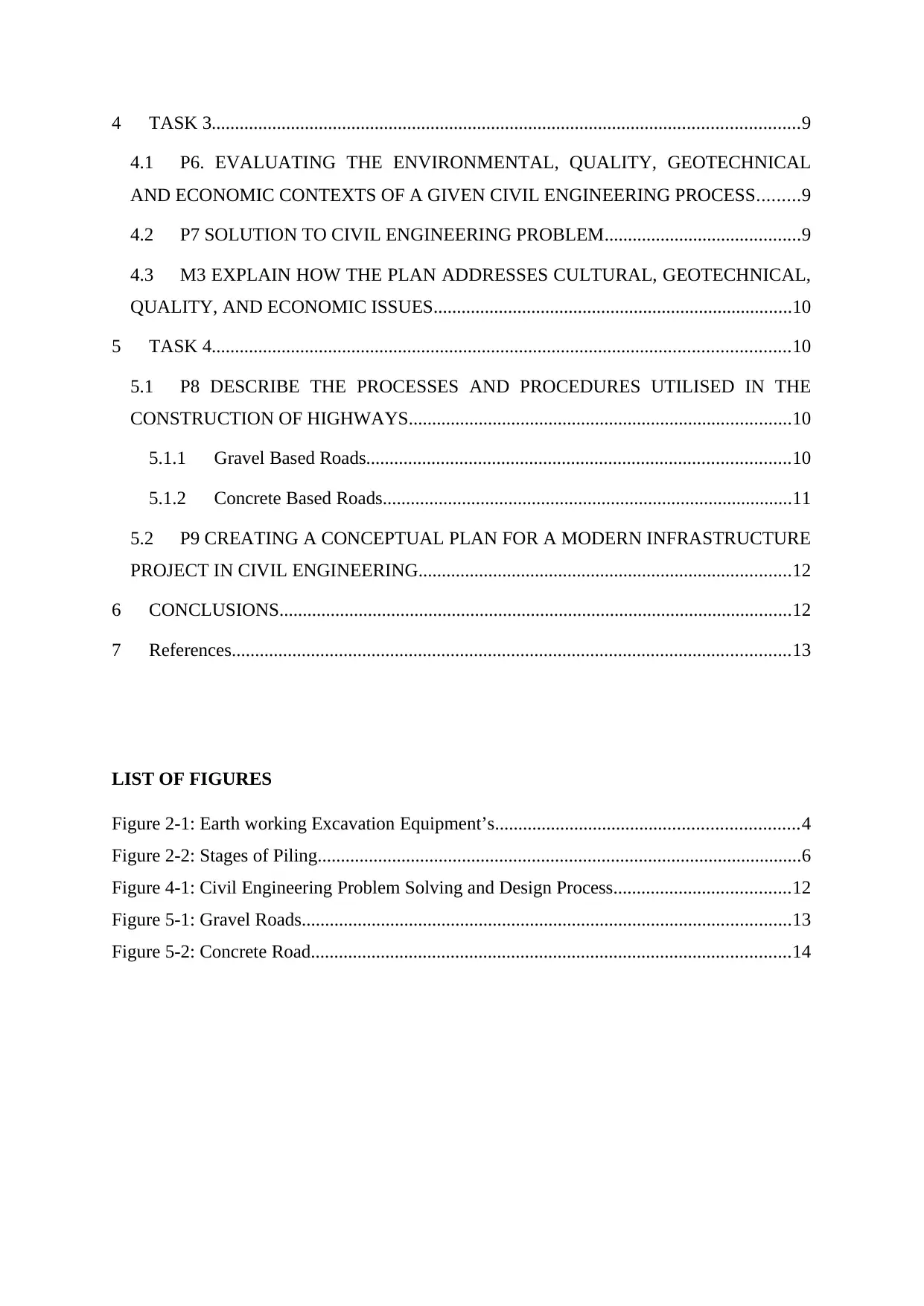
4 TASK 3..............................................................................................................................9
4.1 P6. EVALUATING THE ENVIRONMENTAL, QUALITY, GEOTECHNICAL
AND ECONOMIC CONTEXTS OF A GIVEN CIVIL ENGINEERING PROCESS.........9
4.2 P7 SOLUTION TO CIVIL ENGINEERING PROBLEM..........................................9
4.3 M3 EXPLAIN HOW THE PLAN ADDRESSES CULTURAL, GEOTECHNICAL,
QUALITY, AND ECONOMIC ISSUES.............................................................................10
5 TASK 4............................................................................................................................10
5.1 P8 DESCRIBE THE PROCESSES AND PROCEDURES UTILISED IN THE
CONSTRUCTION OF HIGHWAYS..................................................................................10
5.1.1 Gravel Based Roads...........................................................................................10
5.1.2 Concrete Based Roads........................................................................................11
5.2 P9 CREATING A CONCEPTUAL PLAN FOR A MODERN INFRASTRUCTURE
PROJECT IN CIVIL ENGINEERING................................................................................12
6 CONCLUSIONS..............................................................................................................12
7 References........................................................................................................................13
LIST OF FIGURES
Figure 2-1: Earth working Excavation Equipment’s.................................................................4
Figure 2-2: Stages of Piling........................................................................................................6
Figure 4-1: Civil Engineering Problem Solving and Design Process......................................12
Figure 5-1: Gravel Roads.........................................................................................................13
Figure 5-2: Concrete Road.......................................................................................................14
4.1 P6. EVALUATING THE ENVIRONMENTAL, QUALITY, GEOTECHNICAL
AND ECONOMIC CONTEXTS OF A GIVEN CIVIL ENGINEERING PROCESS.........9
4.2 P7 SOLUTION TO CIVIL ENGINEERING PROBLEM..........................................9
4.3 M3 EXPLAIN HOW THE PLAN ADDRESSES CULTURAL, GEOTECHNICAL,
QUALITY, AND ECONOMIC ISSUES.............................................................................10
5 TASK 4............................................................................................................................10
5.1 P8 DESCRIBE THE PROCESSES AND PROCEDURES UTILISED IN THE
CONSTRUCTION OF HIGHWAYS..................................................................................10
5.1.1 Gravel Based Roads...........................................................................................10
5.1.2 Concrete Based Roads........................................................................................11
5.2 P9 CREATING A CONCEPTUAL PLAN FOR A MODERN INFRASTRUCTURE
PROJECT IN CIVIL ENGINEERING................................................................................12
6 CONCLUSIONS..............................................................................................................12
7 References........................................................................................................................13
LIST OF FIGURES
Figure 2-1: Earth working Excavation Equipment’s.................................................................4
Figure 2-2: Stages of Piling........................................................................................................6
Figure 4-1: Civil Engineering Problem Solving and Design Process......................................12
Figure 5-1: Gravel Roads.........................................................................................................13
Figure 5-2: Concrete Road.......................................................................................................14
⊘ This is a preview!⊘
Do you want full access?
Subscribe today to unlock all pages.

Trusted by 1+ million students worldwide
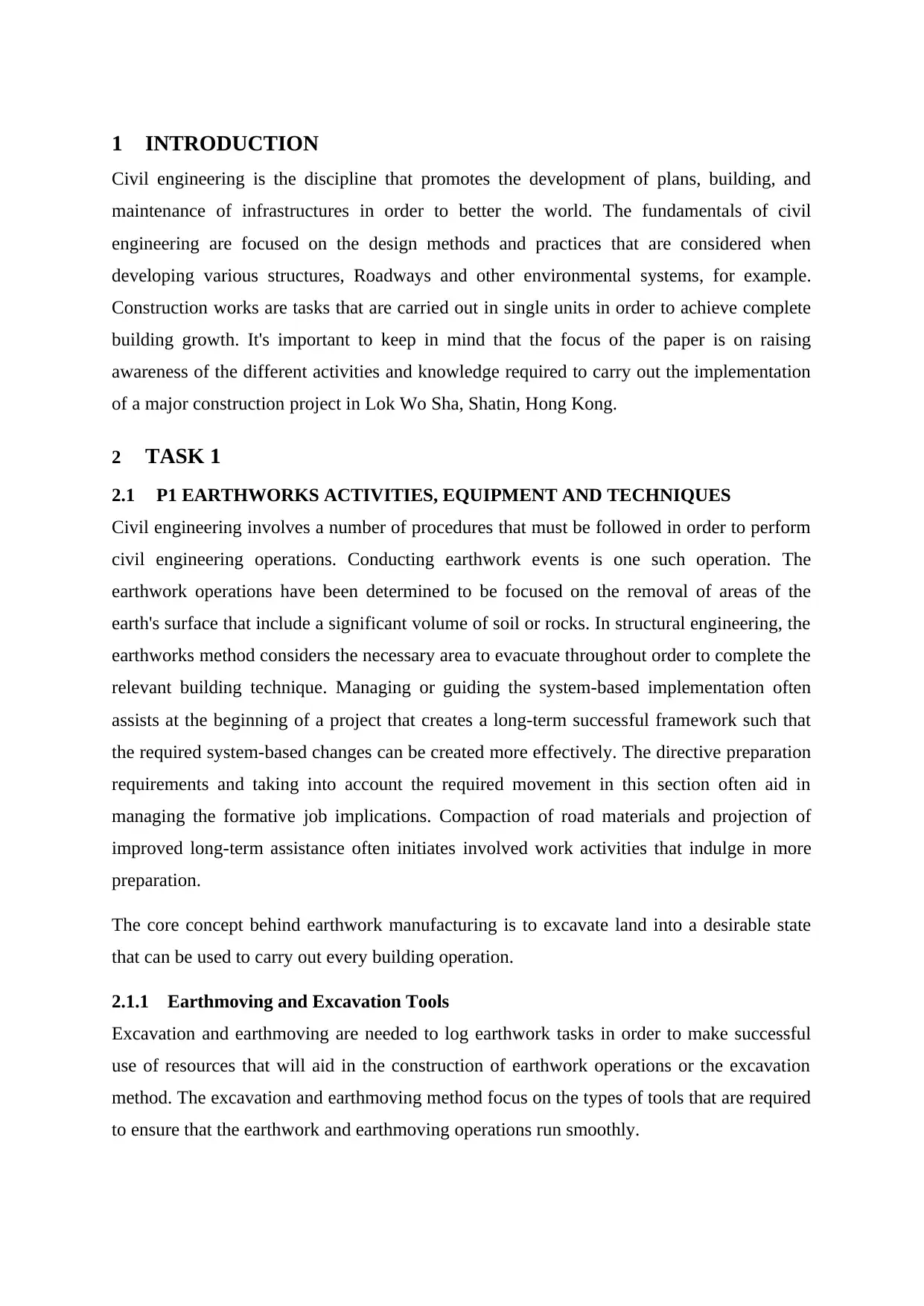
1 INTRODUCTION
Civil engineering is the discipline that promotes the development of plans, building, and
maintenance of infrastructures in order to better the world. The fundamentals of civil
engineering are focused on the design methods and practices that are considered when
developing various structures, Roadways and other environmental systems, for example.
Construction works are tasks that are carried out in single units in order to achieve complete
building growth. It's important to keep in mind that the focus of the paper is on raising
awareness of the different activities and knowledge required to carry out the implementation
of a major construction project in Lok Wo Sha, Shatin, Hong Kong.
2 TASK 1
2.1 P1 EARTHWORKS ACTIVITIES, EQUIPMENT AND TECHNIQUES
Civil engineering involves a number of procedures that must be followed in order to perform
civil engineering operations. Conducting earthwork events is one such operation. The
earthwork operations have been determined to be focused on the removal of areas of the
earth's surface that include a significant volume of soil or rocks. In structural engineering, the
earthworks method considers the necessary area to evacuate throughout order to complete the
relevant building technique. Managing or guiding the system-based implementation often
assists at the beginning of a project that creates a long-term successful framework such that
the required system-based changes can be created more effectively. The directive preparation
requirements and taking into account the required movement in this section often aid in
managing the formative job implications. Compaction of road materials and projection of
improved long-term assistance often initiates involved work activities that indulge in more
preparation.
The core concept behind earthwork manufacturing is to excavate land into a desirable state
that can be used to carry out every building operation.
2.1.1 Earthmoving and Excavation Tools
Excavation and earthmoving are needed to log earthwork tasks in order to make successful
use of resources that will aid in the construction of earthwork operations or the excavation
method. The excavation and earthmoving method focus on the types of tools that are required
to ensure that the earthwork and earthmoving operations run smoothly.
Civil engineering is the discipline that promotes the development of plans, building, and
maintenance of infrastructures in order to better the world. The fundamentals of civil
engineering are focused on the design methods and practices that are considered when
developing various structures, Roadways and other environmental systems, for example.
Construction works are tasks that are carried out in single units in order to achieve complete
building growth. It's important to keep in mind that the focus of the paper is on raising
awareness of the different activities and knowledge required to carry out the implementation
of a major construction project in Lok Wo Sha, Shatin, Hong Kong.
2 TASK 1
2.1 P1 EARTHWORKS ACTIVITIES, EQUIPMENT AND TECHNIQUES
Civil engineering involves a number of procedures that must be followed in order to perform
civil engineering operations. Conducting earthwork events is one such operation. The
earthwork operations have been determined to be focused on the removal of areas of the
earth's surface that include a significant volume of soil or rocks. In structural engineering, the
earthworks method considers the necessary area to evacuate throughout order to complete the
relevant building technique. Managing or guiding the system-based implementation often
assists at the beginning of a project that creates a long-term successful framework such that
the required system-based changes can be created more effectively. The directive preparation
requirements and taking into account the required movement in this section often aid in
managing the formative job implications. Compaction of road materials and projection of
improved long-term assistance often initiates involved work activities that indulge in more
preparation.
The core concept behind earthwork manufacturing is to excavate land into a desirable state
that can be used to carry out every building operation.
2.1.1 Earthmoving and Excavation Tools
Excavation and earthmoving are needed to log earthwork tasks in order to make successful
use of resources that will aid in the construction of earthwork operations or the excavation
method. The excavation and earthmoving method focus on the types of tools that are required
to ensure that the earthwork and earthmoving operations run smoothly.
Paraphrase This Document
Need a fresh take? Get an instant paraphrase of this document with our AI Paraphraser
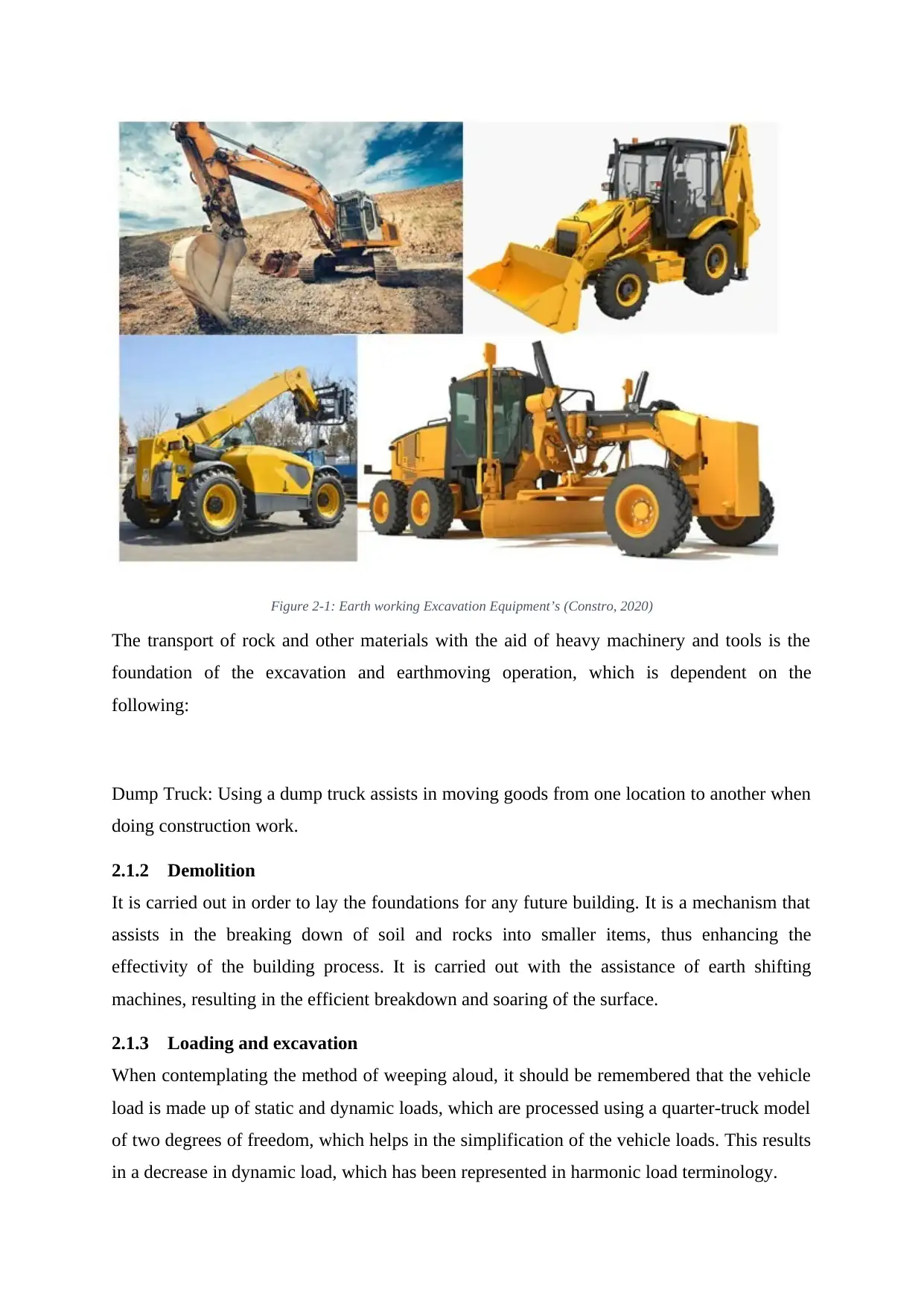
Figure 2-1: Earth working Excavation Equipment’s (Constro, 2020)
The transport of rock and other materials with the aid of heavy machinery and tools is the
foundation of the excavation and earthmoving operation, which is dependent on the
following:
Dump Truck: Using a dump truck assists in moving goods from one location to another when
doing construction work.
2.1.2 Demolition
It is carried out in order to lay the foundations for any future building. It is a mechanism that
assists in the breaking down of soil and rocks into smaller items, thus enhancing the
effectivity of the building process. It is carried out with the assistance of earth shifting
machines, resulting in the efficient breakdown and soaring of the surface.
2.1.3 Loading and excavation
When contemplating the method of weeping aloud, it should be remembered that the vehicle
load is made up of static and dynamic loads, which are processed using a quarter-truck model
of two degrees of freedom, which helps in the simplification of the vehicle loads. This results
in a decrease in dynamic load, which has been represented in harmonic load terminology.
The transport of rock and other materials with the aid of heavy machinery and tools is the
foundation of the excavation and earthmoving operation, which is dependent on the
following:
Dump Truck: Using a dump truck assists in moving goods from one location to another when
doing construction work.
2.1.2 Demolition
It is carried out in order to lay the foundations for any future building. It is a mechanism that
assists in the breaking down of soil and rocks into smaller items, thus enhancing the
effectivity of the building process. It is carried out with the assistance of earth shifting
machines, resulting in the efficient breakdown and soaring of the surface.
2.1.3 Loading and excavation
When contemplating the method of weeping aloud, it should be remembered that the vehicle
load is made up of static and dynamic loads, which are processed using a quarter-truck model
of two degrees of freedom, which helps in the simplification of the vehicle loads. This results
in a decrease in dynamic load, which has been represented in harmonic load terminology.
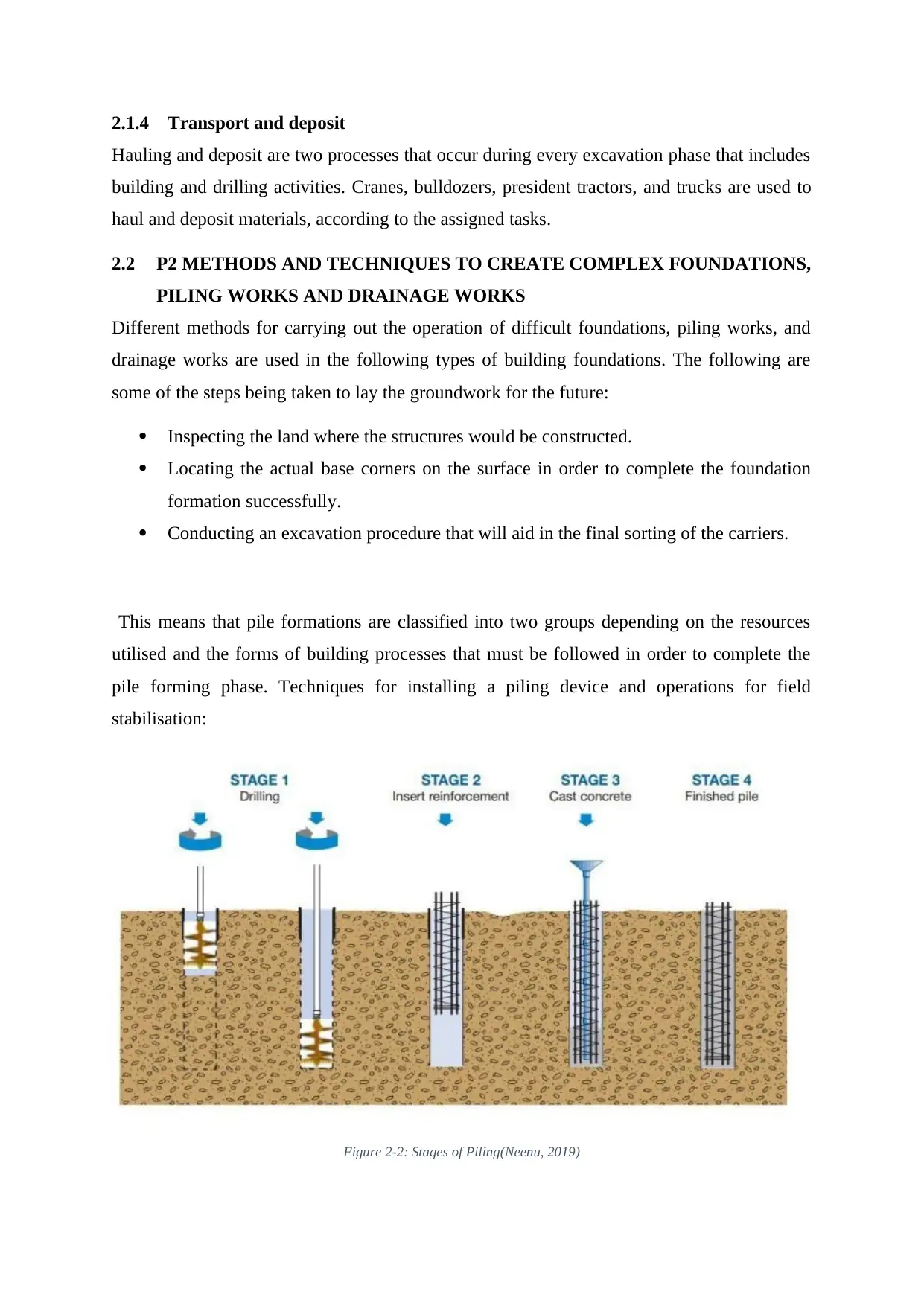
2.1.4 Transport and deposit
Hauling and deposit are two processes that occur during every excavation phase that includes
building and drilling activities. Cranes, bulldozers, president tractors, and trucks are used to
haul and deposit materials, according to the assigned tasks.
2.2 P2 METHODS AND TECHNIQUES TO CREATE COMPLEX FOUNDATIONS,
PILING WORKS AND DRAINAGE WORKS
Different methods for carrying out the operation of difficult foundations, piling works, and
drainage works are used in the following types of building foundations. The following are
some of the steps being taken to lay the groundwork for the future:
Inspecting the land where the structures would be constructed.
Locating the actual base corners on the surface in order to complete the foundation
formation successfully.
Conducting an excavation procedure that will aid in the final sorting of the carriers.
This means that pile formations are classified into two groups depending on the resources
utilised and the forms of building processes that must be followed in order to complete the
pile forming phase. Techniques for installing a piling device and operations for field
stabilisation:
Figure 2-2: Stages of Piling(Neenu, 2019)
Hauling and deposit are two processes that occur during every excavation phase that includes
building and drilling activities. Cranes, bulldozers, president tractors, and trucks are used to
haul and deposit materials, according to the assigned tasks.
2.2 P2 METHODS AND TECHNIQUES TO CREATE COMPLEX FOUNDATIONS,
PILING WORKS AND DRAINAGE WORKS
Different methods for carrying out the operation of difficult foundations, piling works, and
drainage works are used in the following types of building foundations. The following are
some of the steps being taken to lay the groundwork for the future:
Inspecting the land where the structures would be constructed.
Locating the actual base corners on the surface in order to complete the foundation
formation successfully.
Conducting an excavation procedure that will aid in the final sorting of the carriers.
This means that pile formations are classified into two groups depending on the resources
utilised and the forms of building processes that must be followed in order to complete the
pile forming phase. Techniques for installing a piling device and operations for field
stabilisation:
Figure 2-2: Stages of Piling(Neenu, 2019)
⊘ This is a preview!⊘
Do you want full access?
Subscribe today to unlock all pages.

Trusted by 1+ million students worldwide
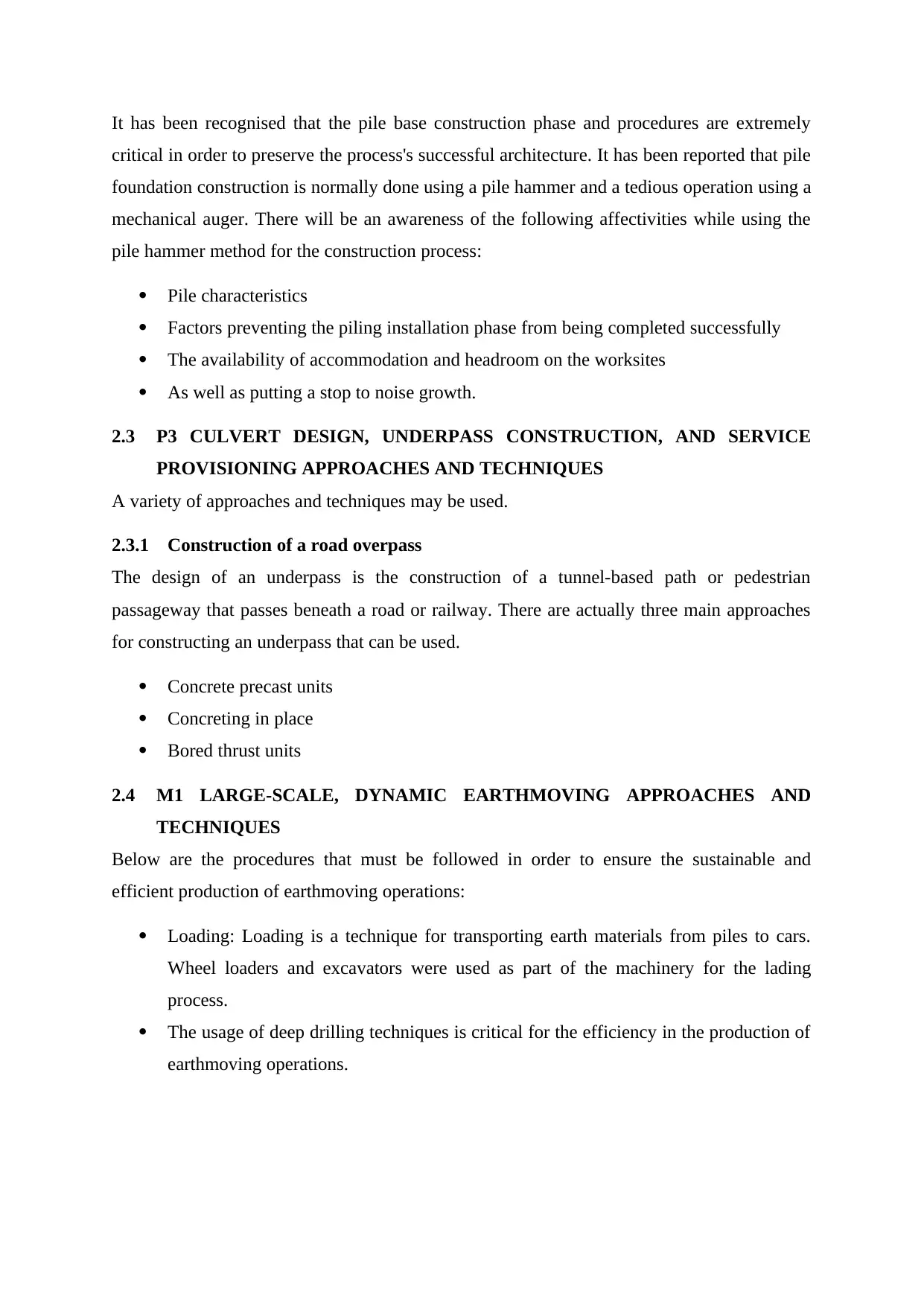
It has been recognised that the pile base construction phase and procedures are extremely
critical in order to preserve the process's successful architecture. It has been reported that pile
foundation construction is normally done using a pile hammer and a tedious operation using a
mechanical auger. There will be an awareness of the following affectivities while using the
pile hammer method for the construction process:
Pile characteristics
Factors preventing the piling installation phase from being completed successfully
The availability of accommodation and headroom on the worksites
As well as putting a stop to noise growth.
2.3 P3 CULVERT DESIGN, UNDERPASS CONSTRUCTION, AND SERVICE
PROVISIONING APPROACHES AND TECHNIQUES
A variety of approaches and techniques may be used.
2.3.1 Construction of a road overpass
The design of an underpass is the construction of a tunnel-based path or pedestrian
passageway that passes beneath a road or railway. There are actually three main approaches
for constructing an underpass that can be used.
Concrete precast units
Concreting in place
Bored thrust units
2.4 M1 LARGE-SCALE, DYNAMIC EARTHMOVING APPROACHES AND
TECHNIQUES
Below are the procedures that must be followed in order to ensure the sustainable and
efficient production of earthmoving operations:
Loading: Loading is a technique for transporting earth materials from piles to cars.
Wheel loaders and excavators were used as part of the machinery for the lading
process.
The usage of deep drilling techniques is critical for the efficiency in the production of
earthmoving operations.
critical in order to preserve the process's successful architecture. It has been reported that pile
foundation construction is normally done using a pile hammer and a tedious operation using a
mechanical auger. There will be an awareness of the following affectivities while using the
pile hammer method for the construction process:
Pile characteristics
Factors preventing the piling installation phase from being completed successfully
The availability of accommodation and headroom on the worksites
As well as putting a stop to noise growth.
2.3 P3 CULVERT DESIGN, UNDERPASS CONSTRUCTION, AND SERVICE
PROVISIONING APPROACHES AND TECHNIQUES
A variety of approaches and techniques may be used.
2.3.1 Construction of a road overpass
The design of an underpass is the construction of a tunnel-based path or pedestrian
passageway that passes beneath a road or railway. There are actually three main approaches
for constructing an underpass that can be used.
Concrete precast units
Concreting in place
Bored thrust units
2.4 M1 LARGE-SCALE, DYNAMIC EARTHMOVING APPROACHES AND
TECHNIQUES
Below are the procedures that must be followed in order to ensure the sustainable and
efficient production of earthmoving operations:
Loading: Loading is a technique for transporting earth materials from piles to cars.
Wheel loaders and excavators were used as part of the machinery for the lading
process.
The usage of deep drilling techniques is critical for the efficiency in the production of
earthmoving operations.
Paraphrase This Document
Need a fresh take? Get an instant paraphrase of this document with our AI Paraphraser
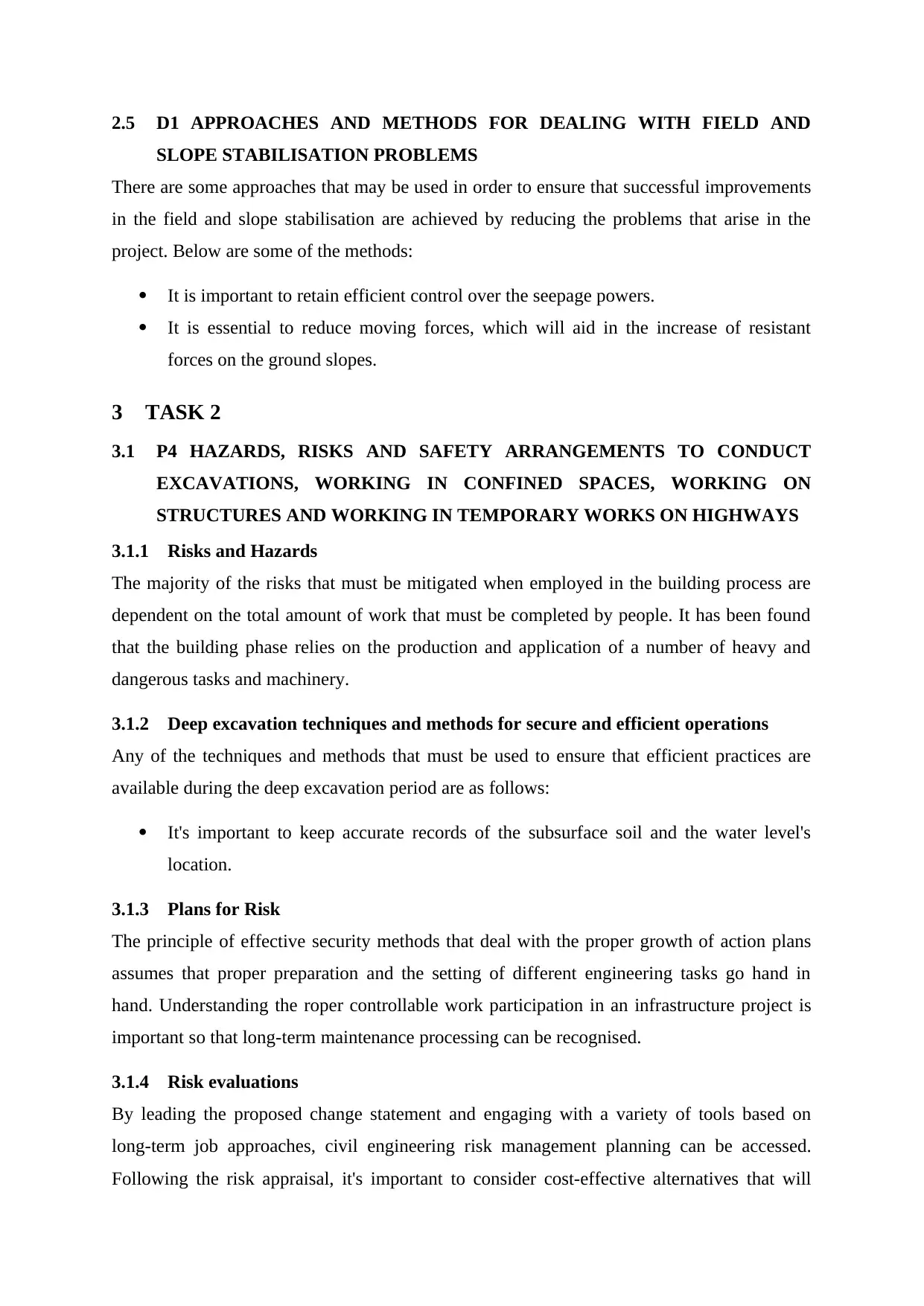
2.5 D1 APPROACHES AND METHODS FOR DEALING WITH FIELD AND
SLOPE STABILISATION PROBLEMS
There are some approaches that may be used in order to ensure that successful improvements
in the field and slope stabilisation are achieved by reducing the problems that arise in the
project. Below are some of the methods:
It is important to retain efficient control over the seepage powers.
It is essential to reduce moving forces, which will aid in the increase of resistant
forces on the ground slopes.
3 TASK 2
3.1 P4 HAZARDS, RISKS AND SAFETY ARRANGEMENTS TO CONDUCT
EXCAVATIONS, WORKING IN CONFINED SPACES, WORKING ON
STRUCTURES AND WORKING IN TEMPORARY WORKS ON HIGHWAYS
3.1.1 Risks and Hazards
The majority of the risks that must be mitigated when employed in the building process are
dependent on the total amount of work that must be completed by people. It has been found
that the building phase relies on the production and application of a number of heavy and
dangerous tasks and machinery.
3.1.2 Deep excavation techniques and methods for secure and efficient operations
Any of the techniques and methods that must be used to ensure that efficient practices are
available during the deep excavation period are as follows:
It's important to keep accurate records of the subsurface soil and the water level's
location.
3.1.3 Plans for Risk
The principle of effective security methods that deal with the proper growth of action plans
assumes that proper preparation and the setting of different engineering tasks go hand in
hand. Understanding the roper controllable work participation in an infrastructure project is
important so that long-term maintenance processing can be recognised.
3.1.4 Risk evaluations
By leading the proposed change statement and engaging with a variety of tools based on
long-term job approaches, civil engineering risk management planning can be accessed.
Following the risk appraisal, it's important to consider cost-effective alternatives that will
SLOPE STABILISATION PROBLEMS
There are some approaches that may be used in order to ensure that successful improvements
in the field and slope stabilisation are achieved by reducing the problems that arise in the
project. Below are some of the methods:
It is important to retain efficient control over the seepage powers.
It is essential to reduce moving forces, which will aid in the increase of resistant
forces on the ground slopes.
3 TASK 2
3.1 P4 HAZARDS, RISKS AND SAFETY ARRANGEMENTS TO CONDUCT
EXCAVATIONS, WORKING IN CONFINED SPACES, WORKING ON
STRUCTURES AND WORKING IN TEMPORARY WORKS ON HIGHWAYS
3.1.1 Risks and Hazards
The majority of the risks that must be mitigated when employed in the building process are
dependent on the total amount of work that must be completed by people. It has been found
that the building phase relies on the production and application of a number of heavy and
dangerous tasks and machinery.
3.1.2 Deep excavation techniques and methods for secure and efficient operations
Any of the techniques and methods that must be used to ensure that efficient practices are
available during the deep excavation period are as follows:
It's important to keep accurate records of the subsurface soil and the water level's
location.
3.1.3 Plans for Risk
The principle of effective security methods that deal with the proper growth of action plans
assumes that proper preparation and the setting of different engineering tasks go hand in
hand. Understanding the roper controllable work participation in an infrastructure project is
important so that long-term maintenance processing can be recognised.
3.1.4 Risk evaluations
By leading the proposed change statement and engaging with a variety of tools based on
long-term job approaches, civil engineering risk management planning can be accessed.
Following the risk appraisal, it's important to consider cost-effective alternatives that will
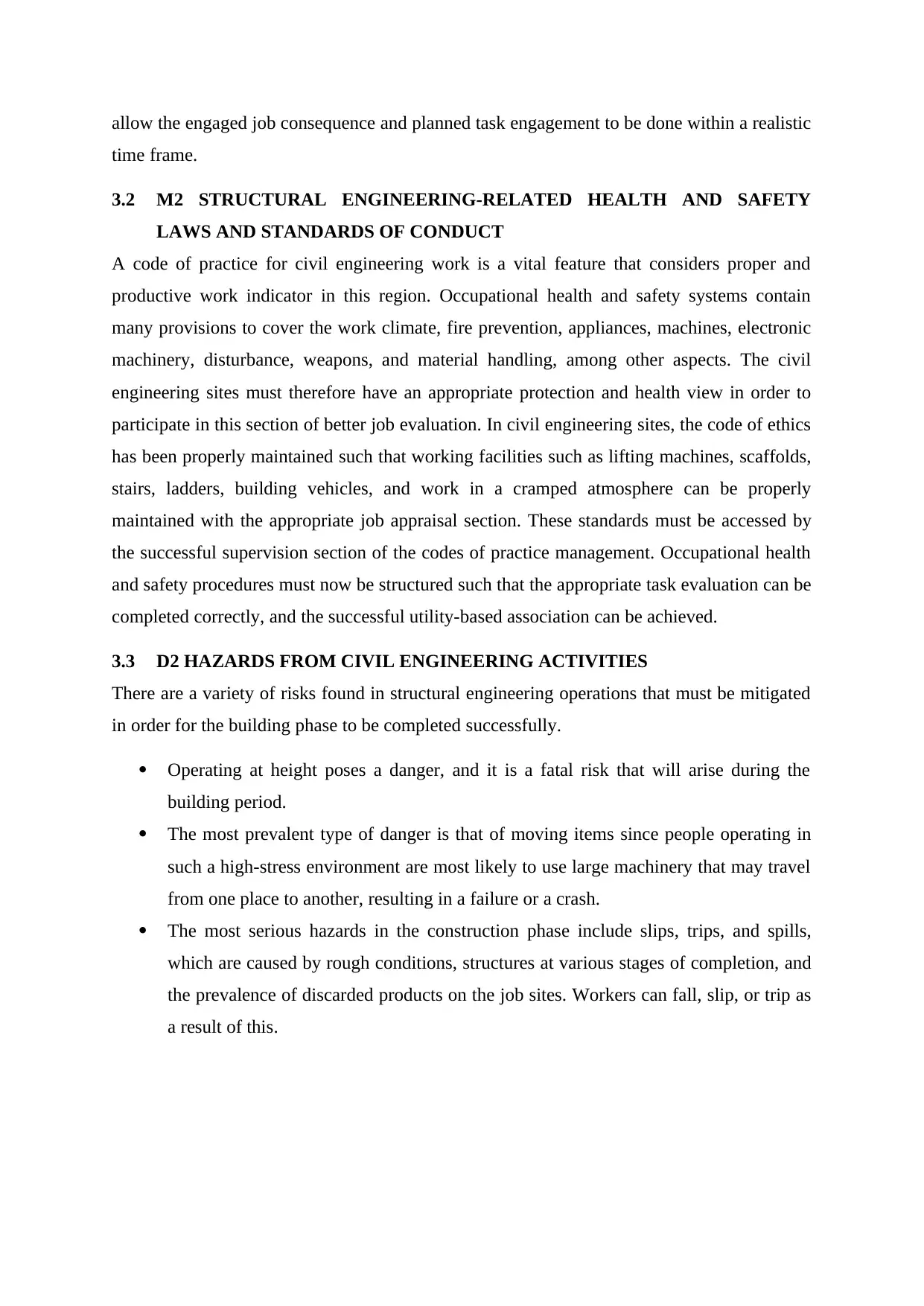
allow the engaged job consequence and planned task engagement to be done within a realistic
time frame.
3.2 M2 STRUCTURAL ENGINEERING-RELATED HEALTH AND SAFETY
LAWS AND STANDARDS OF CONDUCT
A code of practice for civil engineering work is a vital feature that considers proper and
productive work indicator in this region. Occupational health and safety systems contain
many provisions to cover the work climate, fire prevention, appliances, machines, electronic
machinery, disturbance, weapons, and material handling, among other aspects. The civil
engineering sites must therefore have an appropriate protection and health view in order to
participate in this section of better job evaluation. In civil engineering sites, the code of ethics
has been properly maintained such that working facilities such as lifting machines, scaffolds,
stairs, ladders, building vehicles, and work in a cramped atmosphere can be properly
maintained with the appropriate job appraisal section. These standards must be accessed by
the successful supervision section of the codes of practice management. Occupational health
and safety procedures must now be structured such that the appropriate task evaluation can be
completed correctly, and the successful utility-based association can be achieved.
3.3 D2 HAZARDS FROM CIVIL ENGINEERING ACTIVITIES
There are a variety of risks found in structural engineering operations that must be mitigated
in order for the building phase to be completed successfully.
Operating at height poses a danger, and it is a fatal risk that will arise during the
building period.
The most prevalent type of danger is that of moving items since people operating in
such a high-stress environment are most likely to use large machinery that may travel
from one place to another, resulting in a failure or a crash.
The most serious hazards in the construction phase include slips, trips, and spills,
which are caused by rough conditions, structures at various stages of completion, and
the prevalence of discarded products on the job sites. Workers can fall, slip, or trip as
a result of this.
time frame.
3.2 M2 STRUCTURAL ENGINEERING-RELATED HEALTH AND SAFETY
LAWS AND STANDARDS OF CONDUCT
A code of practice for civil engineering work is a vital feature that considers proper and
productive work indicator in this region. Occupational health and safety systems contain
many provisions to cover the work climate, fire prevention, appliances, machines, electronic
machinery, disturbance, weapons, and material handling, among other aspects. The civil
engineering sites must therefore have an appropriate protection and health view in order to
participate in this section of better job evaluation. In civil engineering sites, the code of ethics
has been properly maintained such that working facilities such as lifting machines, scaffolds,
stairs, ladders, building vehicles, and work in a cramped atmosphere can be properly
maintained with the appropriate job appraisal section. These standards must be accessed by
the successful supervision section of the codes of practice management. Occupational health
and safety procedures must now be structured such that the appropriate task evaluation can be
completed correctly, and the successful utility-based association can be achieved.
3.3 D2 HAZARDS FROM CIVIL ENGINEERING ACTIVITIES
There are a variety of risks found in structural engineering operations that must be mitigated
in order for the building phase to be completed successfully.
Operating at height poses a danger, and it is a fatal risk that will arise during the
building period.
The most prevalent type of danger is that of moving items since people operating in
such a high-stress environment are most likely to use large machinery that may travel
from one place to another, resulting in a failure or a crash.
The most serious hazards in the construction phase include slips, trips, and spills,
which are caused by rough conditions, structures at various stages of completion, and
the prevalence of discarded products on the job sites. Workers can fall, slip, or trip as
a result of this.
⊘ This is a preview!⊘
Do you want full access?
Subscribe today to unlock all pages.

Trusted by 1+ million students worldwide
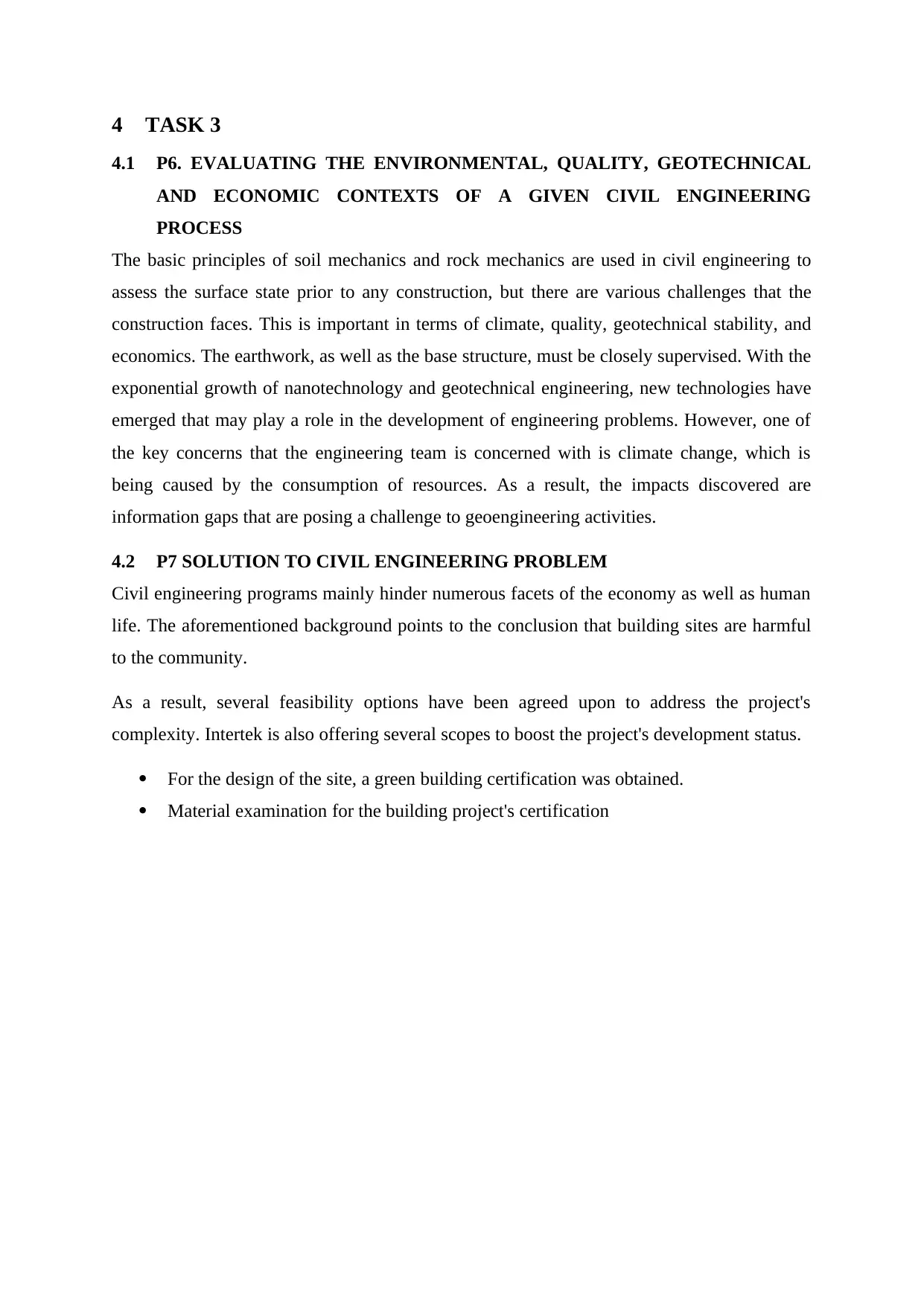
4 TASK 3
4.1 P6. EVALUATING THE ENVIRONMENTAL, QUALITY, GEOTECHNICAL
AND ECONOMIC CONTEXTS OF A GIVEN CIVIL ENGINEERING
PROCESS
The basic principles of soil mechanics and rock mechanics are used in civil engineering to
assess the surface state prior to any construction, but there are various challenges that the
construction faces. This is important in terms of climate, quality, geotechnical stability, and
economics. The earthwork, as well as the base structure, must be closely supervised. With the
exponential growth of nanotechnology and geotechnical engineering, new technologies have
emerged that may play a role in the development of engineering problems. However, one of
the key concerns that the engineering team is concerned with is climate change, which is
being caused by the consumption of resources. As a result, the impacts discovered are
information gaps that are posing a challenge to geoengineering activities.
4.2 P7 SOLUTION TO CIVIL ENGINEERING PROBLEM
Civil engineering programs mainly hinder numerous facets of the economy as well as human
life. The aforementioned background points to the conclusion that building sites are harmful
to the community.
As a result, several feasibility options have been agreed upon to address the project's
complexity. Intertek is also offering several scopes to boost the project's development status.
For the design of the site, a green building certification was obtained.
Material examination for the building project's certification
4.1 P6. EVALUATING THE ENVIRONMENTAL, QUALITY, GEOTECHNICAL
AND ECONOMIC CONTEXTS OF A GIVEN CIVIL ENGINEERING
PROCESS
The basic principles of soil mechanics and rock mechanics are used in civil engineering to
assess the surface state prior to any construction, but there are various challenges that the
construction faces. This is important in terms of climate, quality, geotechnical stability, and
economics. The earthwork, as well as the base structure, must be closely supervised. With the
exponential growth of nanotechnology and geotechnical engineering, new technologies have
emerged that may play a role in the development of engineering problems. However, one of
the key concerns that the engineering team is concerned with is climate change, which is
being caused by the consumption of resources. As a result, the impacts discovered are
information gaps that are posing a challenge to geoengineering activities.
4.2 P7 SOLUTION TO CIVIL ENGINEERING PROBLEM
Civil engineering programs mainly hinder numerous facets of the economy as well as human
life. The aforementioned background points to the conclusion that building sites are harmful
to the community.
As a result, several feasibility options have been agreed upon to address the project's
complexity. Intertek is also offering several scopes to boost the project's development status.
For the design of the site, a green building certification was obtained.
Material examination for the building project's certification
Paraphrase This Document
Need a fresh take? Get an instant paraphrase of this document with our AI Paraphraser
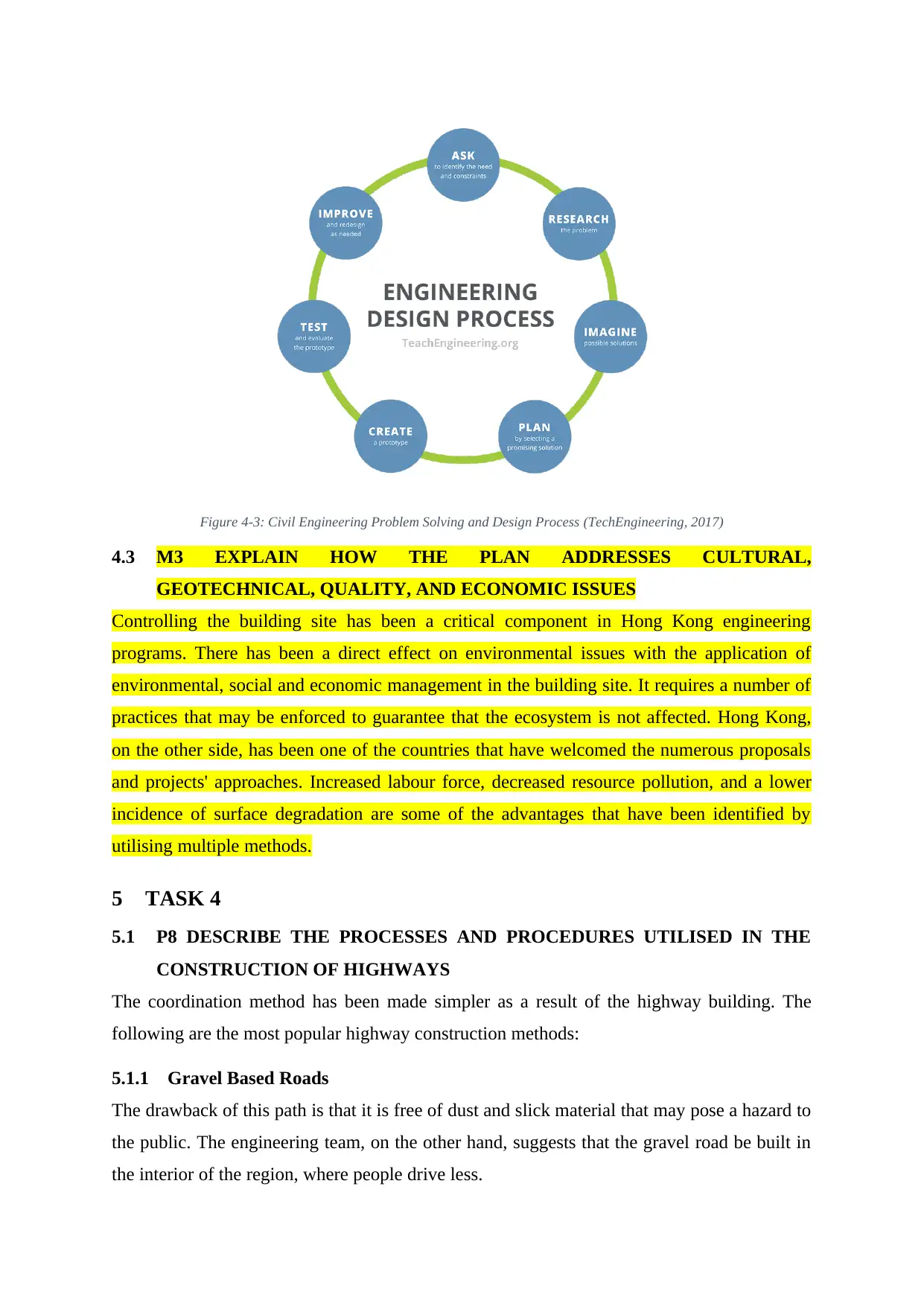
Figure 4-3: Civil Engineering Problem Solving and Design Process (TechEngineering, 2017)
4.3 M3 EXPLAIN HOW THE PLAN ADDRESSES CULTURAL,
GEOTECHNICAL, QUALITY, AND ECONOMIC ISSUES
Controlling the building site has been a critical component in Hong Kong engineering
programs. There has been a direct effect on environmental issues with the application of
environmental, social and economic management in the building site. It requires a number of
practices that may be enforced to guarantee that the ecosystem is not affected. Hong Kong,
on the other side, has been one of the countries that have welcomed the numerous proposals
and projects' approaches. Increased labour force, decreased resource pollution, and a lower
incidence of surface degradation are some of the advantages that have been identified by
utilising multiple methods.
5 TASK 4
5.1 P8 DESCRIBE THE PROCESSES AND PROCEDURES UTILISED IN THE
CONSTRUCTION OF HIGHWAYS
The coordination method has been made simpler as a result of the highway building. The
following are the most popular highway construction methods:
5.1.1 Gravel Based Roads
The drawback of this path is that it is free of dust and slick material that may pose a hazard to
the public. The engineering team, on the other hand, suggests that the gravel road be built in
the interior of the region, where people drive less.
4.3 M3 EXPLAIN HOW THE PLAN ADDRESSES CULTURAL,
GEOTECHNICAL, QUALITY, AND ECONOMIC ISSUES
Controlling the building site has been a critical component in Hong Kong engineering
programs. There has been a direct effect on environmental issues with the application of
environmental, social and economic management in the building site. It requires a number of
practices that may be enforced to guarantee that the ecosystem is not affected. Hong Kong,
on the other side, has been one of the countries that have welcomed the numerous proposals
and projects' approaches. Increased labour force, decreased resource pollution, and a lower
incidence of surface degradation are some of the advantages that have been identified by
utilising multiple methods.
5 TASK 4
5.1 P8 DESCRIBE THE PROCESSES AND PROCEDURES UTILISED IN THE
CONSTRUCTION OF HIGHWAYS
The coordination method has been made simpler as a result of the highway building. The
following are the most popular highway construction methods:
5.1.1 Gravel Based Roads
The drawback of this path is that it is free of dust and slick material that may pose a hazard to
the public. The engineering team, on the other hand, suggests that the gravel road be built in
the interior of the region, where people drive less.
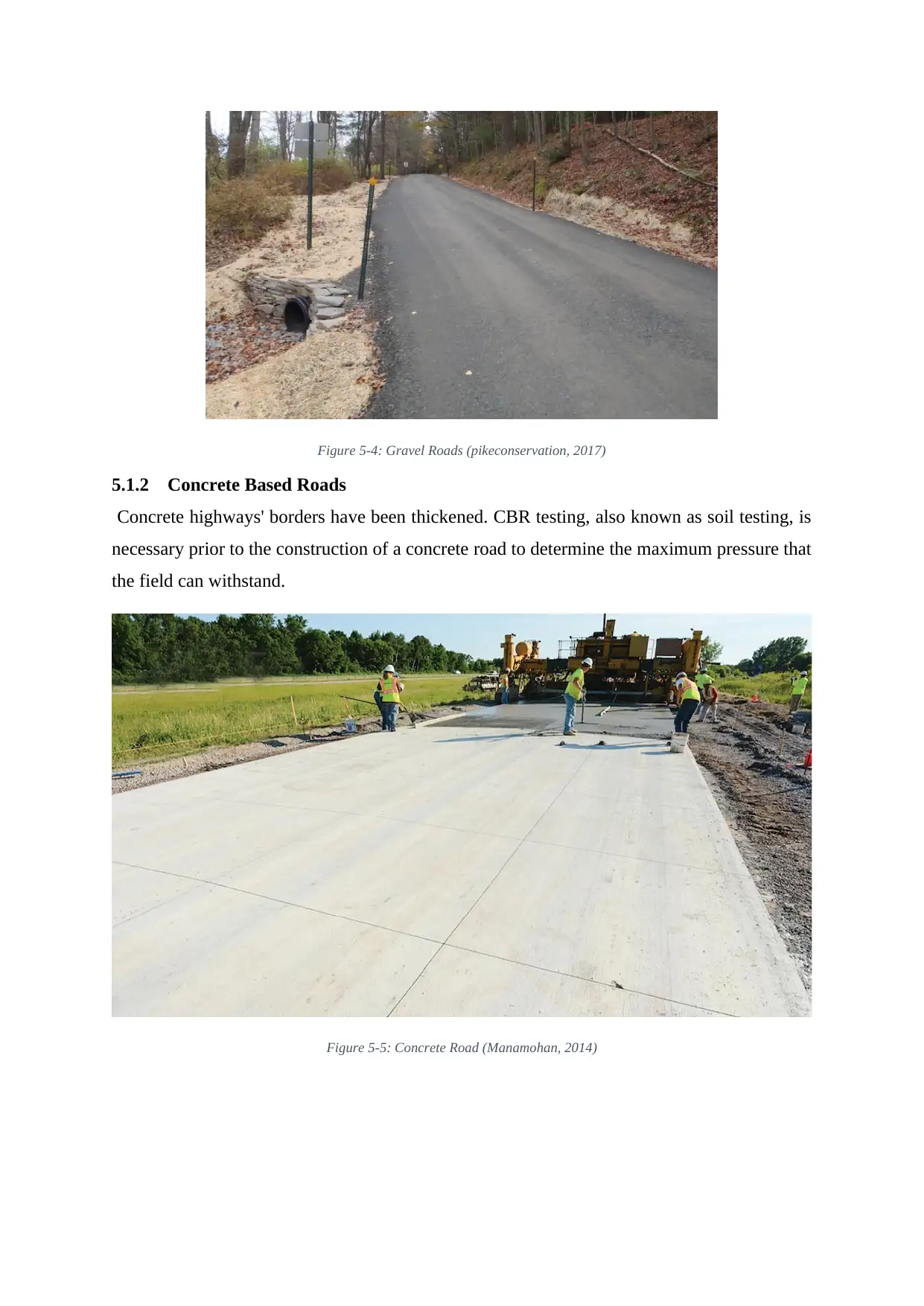
Figure 5-4: Gravel Roads (pikeconservation, 2017)
5.1.2 Concrete Based Roads
Concrete highways' borders have been thickened. CBR testing, also known as soil testing, is
necessary prior to the construction of a concrete road to determine the maximum pressure that
the field can withstand.
Figure 5-5: Concrete Road (Manamohan, 2014)
5.1.2 Concrete Based Roads
Concrete highways' borders have been thickened. CBR testing, also known as soil testing, is
necessary prior to the construction of a concrete road to determine the maximum pressure that
the field can withstand.
Figure 5-5: Concrete Road (Manamohan, 2014)
⊘ This is a preview!⊘
Do you want full access?
Subscribe today to unlock all pages.

Trusted by 1+ million students worldwide
1 out of 14
Related Documents
Your All-in-One AI-Powered Toolkit for Academic Success.
+13062052269
info@desklib.com
Available 24*7 on WhatsApp / Email
![[object Object]](/_next/static/media/star-bottom.7253800d.svg)
Unlock your academic potential
Copyright © 2020–2025 A2Z Services. All Rights Reserved. Developed and managed by ZUCOL.


